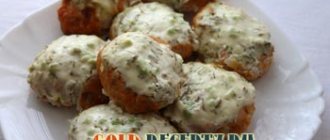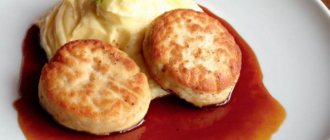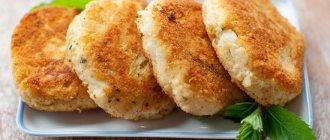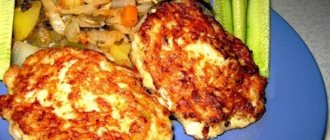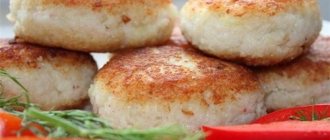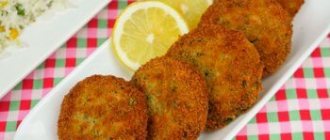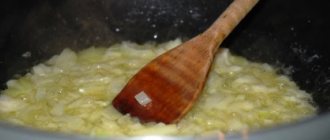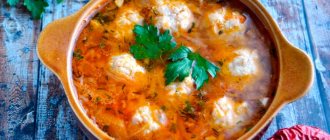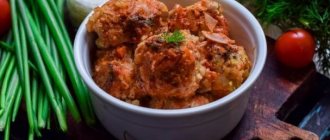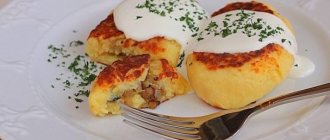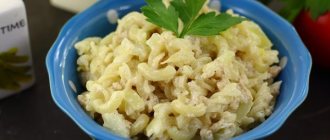PP beef cutlets. Dietary beef cutlets
Diets or proper nutrition are not a reason to give up cutlets! Let's prepare very tasty and completely low-fat dietary beef cutlets in the oven. You can buy ground beef for the cutlets or make your own... Now let's make the cutlet crumbs!
Ingredients:
- Beef (or minced meat) - 200 gr.
- Onion - 1 pc.
- Chicken egg - 1 pc.
- Corn flour (rice/oatmeal/chickpeas) - 4 tbsp.
- Salt - to taste
Preparation:
Grind the beef pieces through a meat grinder. Try to choose the least fatty part of the meat.
Grate the onion on a fine grater, beat the egg. Add them to the minced meat.
TIP: You can use a blender if you don't want to use a grater. But it will be difficult to chop one onion - the volume is too small. And, if you put an egg in the bowl, the mass will be finely crushed and beaten.
Stir the minced meat until smooth and add salt.
Add cornmeal. You can take chickpeas, rice or oatmeal (just grind the oatmeal in a blender or coffee grinder).
Stir again and let the minced meat stand for 15 minutes.
Form into small patties (I made 12) and place on a silicone mat or parchment paper.
Bake in a preheated oven (mode - 180 degrees) until golden brown. If your dietary beef cutlets are also small, then they will need to bake literally 15-20 minutes.
Serve with vegetables. The cutlet crumbs are very tasty and not at all greasy (but not dry either, since the onion gives the meat juiciness). You can also serve them with some kind of dietary sauce.
How to cook “Diet beef cutlets”
1. It is better to start dietary beef cutlets at home by preparing minced meat, then you will definitely be sure of its quality. It is better to choose beef that is as lean as possible and grind the meat in a meat grinder.
2. Peel the onion and cut into large pieces. Grind in a meat grinder and add to the minced meat. Salt and pepper the meat well.
3. Mix the minced meat well. Gradually add milk to it, stirring constantly.
4. It is better to mash each portion of meat for one cutlet several times by hitting it on the table. Thus, the structure will be even more uniform.
5. Take a non-stick frying pan. Heat it well and add the cutlets there. Place them so that they do not interfere with each other, otherwise they may stick together.
6. It is better to fry the cutlets over low heat under a lid. 5 minutes before they are ready, you can remove the lid and fry them until golden brown. You can also put them in the oven to finish cooking.
7. The recipe for making dietary beef cutlets is almost complete. All that remains is to remove the finished cutlets and serve them to the table. They turn out tender, juicy and absolutely not loose.
Dietary dishes made from minced beef. Delicious ground beef dishes for the whole family
You can prepare a variety of dishes from minced beef - the well-known cutlets, meatballs, dumplings, manti and other delicious treats are necessarily made using this tasty and, most importantly, satisfying product.
These treats are actively used for the everyday menu, as well as for the holiday table. Therefore, every housewife must have in her stock several recipes for delicious minced beef dishes.
Meatballs stuffed with cheese in tomato sauce
| Ingredients | Quantity |
| ground beef - | 700 grams |
| onion - | 2 heads |
| garlic - | one head |
| mushrooms - | ¼ kilogram |
| nuts - | 130 grams |
| eggs - | 1 PC. |
| feta cheese - | 100g |
| olive oil - | 4 large spoons |
| tomato - | 600 grams |
| tomato juice - | 2 glasses |
| parsley - | 4-5 stems |
| dried basil - | 1 teaspoon |
| pepper and salt - | taste |
| Cooking time: 60 minutes | Calorie content per 100 grams: 188 Kcal |
How to do it:
- First, peel one onion and cut into small pieces;
- We remove the skin from four teeth and chop it into small slices with a knife or pass it through a crush;
- Grind the nuts until crumbly;
- Rinse a bunch of parsley and chop into small pieces;
- Place minced meat in a cup, add pieces of onion and garlic. We also add nuts and herbs;
- Add one chicken egg, salt and pepper to the minced meat;
- Mix all the ingredients thoroughly, you should get a base with a uniform structure;
- The cheese needs to be cut into 10 cubes;
- Divide the minced meat into 10 parts;
- From each part we make a small flat cake, place a piece of cheese in the center and form round meatballs;
- Add olive oil to a deep frying pan, place on the stove and heat;
- Place the meatballs in hot oil, fry them on both sides for 3-5 minutes and remove from the heat;
- Then we peel the onion and chop it into small pieces;
- Place the onion in another frying pan, add olive oil and place on the fire. Fry for 5 minutes until transparent;
- Rinse the tomatoes, cut them into several parts, put them in a blender and grind until puree;
- Add the tomato mixture to the onion and leave to cook for another 5-7 minutes;
- Then pour in the tomato juice, add salt, basil, pepper and bring to a boil;
- Pour the prepared tomato sauce over the meatballs, remove to the heat and leave to simmer, covered, for 20 minutes.
Recipe for homemade ground beef cutlets. Calorie, chemical composition and nutritional value.
Nutritional value and chemical composition of "PP cutlets from homemade minced beef."
The table shows the nutritional content (calories, proteins, fats, carbohydrates, vitamins and minerals) per 100 grams of edible portion.
| Nutrient | Quantity | Norm** | % of the norm in 100 g | % of the norm in 100 kcal | 100% normal |
| Calorie content | 171.5 kcal | 1684 kcal | 10.2% | 5.9% | 982 g |
| Squirrels | 26.6 g | 76 g | 35% | 20.4% | 286 g |
| Fats | 6.4 g | 56 g | 11.4% | 6.6% | 875 g |
| Carbohydrates | 0.3 g | 219 g | 0.1% | 0.1% | 73000 g |
| Alimentary fiber | 0.1 g | 20 g | 0.5% | 0.3% | 20000 g |
| Water | 66.2 g | 2273 g | 2.9% | 1.7% | 3434 g |
| Ash | 1.114 g | ~ | |||
| Vitamins | |||||
| Vitamin A, RE | 49.8 mcg | 900 mcg | 5.5% | 3.2% | 1807 |
| Retinol | 0.024 mg | ~ | |||
| beta carotene | 0.169 mg | 5 mg | 3.4% | 2% | 2959 g |
| Vitamin B1, thiamine | 0.065 mg | 1.5 mg | 4.3% | 2.5% | 2308 g |
| Vitamin B2, riboflavin | 0.191 mg | 1.8 mg | 10.6% | 6.2% | 942 g |
| Vitamin B4, choline | 119.45 mg | 500 mg | 23.9% | 13.9% | 419 g |
| Vitamin B5, pantothenic | 0.63 mg | 5 mg | 12.6% | 7.3% | 794 g |
| Vitamin B6, pyridoxine | 0.359 mg | 2 mg | 18% | 10.5% | 557 g |
| Vitamin B9, folates | 10.199 mcg | 400 mcg | 2.5% | 1.5% | 3922 g |
| Vitamin B12, cobalamin | 1.44 mcg | 3 mcg | 48% | 28% | 208 g |
| Vitamin C, ascorbic acid | 2.46 mg | 90 mg | 2.7% | 1.6% | 3659 g |
| Vitamin D, calciferol | 0.287 mcg | 10 mcg | 2.9% | 1.7% | 3484 g |
| Vitamin D3, cholecalciferol | 0.085 mcg | ~ | |||
| Vitamin E, alpha tocopherol, TE | 0.455 mg | 15 mg | 3% | 1.7% | 3297 g |
| beta tocopherol | 0.007 mg | ~ | |||
| gamma tocopherol | 0.39 mg | ~ | |||
| delta tocopherol | 0.022 mg | ~ | |||
| Vitamin H, biotin | 2.001 mcg | 50 mcg | 4% | 2.3% | 2499 g |
| Vitamin K, phylloquinone | 29.5 mcg | 120 mcg | 24.6% | 14.3% | 407 g |
| Vitamin RR, NE | 4.9248 mg | 20 mg | 24.6% | 14.3% | 406 g |
| Niacin | 0.044 mg | ~ | |||
| Betaine | 12.627 mg | ~ | |||
| Macronutrients | |||||
| Potassium, K | 239 mg | 2500 mg | 9.6% | 5.6% | 1046 g |
| Calcium, Ca | 18.68 mg | 1000 mg | 1.9% | 1.1% | 5353 g |
| Silicon, Si | 0.228 mg | 30 mg | 0.8% | 0.5% | 13158 g |
| Magnesium, Mg | 20.28 mg | 400 mg | 5.1% | 3% | 1972 |
| Sodium, Na | 46.25 mg | 1300 mg | 3.6% | 2.1% | 2811 g |
| Sera, S | 270.75 mg | 1000 mg | 27.1% | 15.8% | 369 g |
| Phosphorus, P | 179 mg | 800 mg | 22.4% | 13.1% | 447 g |
| Chlorine, Cl | 19.41 mg | 2300 mg | 0.8% | 0.5% | 11850 g |
| Microelements | |||||
| Aluminium, Al | 14.2 mcg | ~ | |||
| Bor, B | 5.8 mcg | ~ | |||
| Vanadium, V | 0.48 mcg | ~ | |||
| Iron, Fe | 2.398 mg | 18 mg | 13.3% | 7.8% | 751 g |
| Yod, I | 1.76 mcg | 150 mcg | 1.2% | 0.7% | 8523 g |
| Cobalt, Co | 1.304 mcg | 10 mcg | 13% | 7.6% | 767 g |
| Lithium, Li | 0.295 mcg | ~ | |||
| Manganese, Mn | 0.0244 mg | 2 mg | 1.2% | 0.7% | 8197 g |
| Copper, Cu | 76.65 mcg | 1000 mcg | 7.7% | 4.5% | 1305 g |
| Molybdenum, Mo | 1.101 mcg | 70 mcg | 1.6% | 0.9% | 6358 g |
| Nickel, Ni | 0.151 mcg | ~ | |||
| Rubidium, Rb | 11.1 mcg | ~ | |||
| Selenium, Se | 31.055 mcg | 55 mcg | 56.5% | 32.9% | 177 g |
| Strontium, Sr | 1.15 mcg | ~ | |||
| Fluorine, F | 8.62 mcg | 4000 mcg | 0.2% | 0.1% | 46404 g |
| Chromium, Cr | 0.63 mcg | 50 mcg | 1.3% | 0.8% | 7937 g |
| Zinc, Zn | 4.429 mg | 12 mg | 36.9% | 21.5% | 271 g |
| Digestible carbohydrates | |||||
| Starch and dextrins | 0.02 g | ~ | |||
| Mono- and disaccharides (sugars) | 0.3 g | max 100 g | |||
| Essential amino acids | |||||
| Arginine* | 1.706 g | ~ | |||
| Valin | 1.324 g | ~ | |||
| Histidine* | 0.837 g | ~ | |||
| Isoleucine | 1.205 g | ~ | |||
| Leucine | 2.109 g | ~ | |||
| Lysine | 2.217 g | ~ | |||
| Methionine | 0.697 g | ~ | |||
| Methionine + Cysteine | 0.07 g | ~ | |||
| Threonine | 1.066 g | ~ | |||
| Tryptophan | 0.185 g | ~ | |||
| Phenylalanine | 1.058 g | ~ | |||
| Phenylalanine+Tyrosine | 0.109 g | ~ | |||
| Nonessential amino acids | |||||
| Alanin | 1.601 g | ~ | |||
| Aspartic acid | 2.414 g | ~ | |||
| Hydroxyproline | 0.264 g | ~ | |||
| Glycine | 1.574 g | ~ | |||
| Glutamic acid | 3.954 g | ~ | |||
| Proline | 1.239 g | ~ | |||
| Serin | 1.082 g | ~ | |||
| Tyrosine | 0.849 g | ~ | |||
| Cysteine | 0.353 g | ~ | |||
| Sterols (sterols) | |||||
| Cholesterol | 116.72 mg | max 300 mg | |||
| Campesterol | 1.329 mg | ~ | |||
| Stigmasterol | 0.407 mg | ~ | |||
| beta sitosterol | 2.793 mg | ~ | |||
| Fatty acid | |||||
| Trans fats | 0.001 g | max 1.9 g | |||
| monounsaturated trans fats | 0.001 g | ~ | |||
| Saturated fatty acids | |||||
| Saturated fatty acids | 1.8 g | max 18.7 g | |||
| 14:0 Miristinovaya | 0.102 g | ~ | |||
| 15:0 Pentadecane | 0.001 g | ~ | |||
| 16:0 Palmitinaya | 1.127 g | ~ | |||
| 17:0 Margarine | 0.004 g | ~ | |||
| 18:0 Stearic | 0.55 g | ~ | |||
| 20:0 Arakhinovaya | 0.005 g | ~ | |||
| 22:0 Begenovaya | 0.002 g | ~ | |||
| 24:0 Lignoceric | 0.001 g | ~ | |||
| Monounsaturated fatty acids | 2.376 g | min 16.8 g | 14.1% | 8.2% | |
| 16:1 Palmitoleic | 0.195 g | ~ | |||
| 16:1 cis | 0.001 g | ~ | |||
| 17:1 Heptadecene | 0.001 g | ~ | |||
| 18:1 Oleic (omega-9) | 2.155 g | ~ | |||
| 18:1 cis | 0.248 g | ~ | |||
| 20:1 Gadoleic (omega-9) | 0.005 g | ~ | |||
| Polyunsaturated fatty acids | 1.213 g | from 11.2 to 20.6 g | 10.8% | 6.3% | |
| 18:2 Linolevaya | 0.426 g | ~ | |||
| 18:2 trans isomer, undetermined | 0.001 g | ~ | |||
| 18:2 Omega-6, cis, cis | 0.193 g | ~ | |||
| 18:3 Linolenic | 0.741 g | ~ | |||
| 18:3 Omega-3, alpha-linolenic | 0.724 g | ~ | |||
| 20:3 Eicosatriene | 0.001 g | ~ | |||
| 20:4 Arachidonic | 0.034 g | ~ | |||
| 20:5 Eicosapentaenoic acid (EPA), Omega-3 | 0.003 g | ~ | |||
| Omega-3 fatty acids | 0.8 g | from 0.9 to 3.7 g | 88.9% | 51.8% | |
| 22:5 Docosapentaenoic acid (DPA), Omega-3 | 0.013 g | ~ | |||
| 22:6 Docosahexaenoic acid (DHA), Omega-3 | 0.001 g | ~ | |||
| Omega-6 fatty acids | 0.5 g | from 4.7 to 16.8 g | 10.6% | 6.2% |
The energy value of a PP cutlet made from homemade minced beef is 171.5 kcal.
- Serving = 98 g (168.1 kcal)
Primary Source: Created in the application by the user. Read more.
** This table shows the average levels of vitamins and minerals for an adult. If you want to know the norms taking into account your gender, age and other factors, then use the “My Healthy Diet” application.
Cutlets on a diet. Cooking dietary chicken cutlets
Chicken fillet cutlets are a dish rich in animal protein, vitamins and minerals. Prepared according to all the rules of a healthy diet, they can be included in the diet menu. Juicy, tasty, tender and soft chicken breast cutlets, steamed or in the oven, will become an indispensable dish for young children. This is also an excellent option for those who monitor their health, prefer low-fat foods, or simply want to lose weight.
Features of the dish
Chicken cutlets are a dish of minced meat or chopped fillet (breast), formed into small flat cakes or koloboks. Unlike pork, lamb or beef, chicken does not contain coarse fibers. Thanks to this feature, poultry dishes are tender and easily digested by the body.
Diet chicken cutlets cook much faster than cutlets made from other types of meat. Steamed dishes are low in calories. Their energy value is no more than 120 kilocalories per 100 grams of finished product. Chicken meat goes well with most vegetables, which can be added to recipes, thereby increasing the nutritional value and healthiness of the dish.
The benefits of dietary chicken cutlets
Poultry meat is rich in animal protein, which is a “building” material for the human muscular frame. Because of this feature, it is often included in the diet of people who play sports or those who adhere to healthy eating rules. Steamed chicken cutlets are suitable for those who are on a diet. They will saturate the body with useful substances and help prevent the development of vitamin deficiency. This dish will be useful for people suffering from gout, diabetes, obesity, stomach ulcers and other diseases of the gastrointestinal tract.
Chicken meat is a source of the following beneficial substances:
- linoleic acid, which stimulates the immune system;
- B vitamins: they have a beneficial effect on the functioning of the cardiovascular system, stimulate the function of the central nervous system, and also strengthen the body;
- niacin - a substance that reduces the risk of developing heart disease, reduces the concentration of cholesterol in the blood, improves the production of gastric juice;
- potassium, manganese, phosphorus and iron, which are contained in an easily digestible form.
Chicken, unlike other types of meat, contains the least amount of fat. Properly prepared chicken cutlets are healthy for everyone. They are recommended for use during excessive mental or physical stress (for muscle recovery or for building muscle mass), during postoperative periods or after protracted or serious illnesses.
Possible harm
Chicken meat contains histamines. In some cases, they can cause allergic reactions. In case of individual intolerance, it is best to exclude chicken from the diet. In this situation, it will do more harm than good.
It’s worth talking in more detail about the quality of chicken, since not all meat is healthy. The fact is that the windows of modern stores are often filled with low-quality products. In order for a kritsa to quickly gain muscle mass, it is often “stuffed” with hormones or other chemical components. This meat has a taste that is unusual for chicken. It cannot be called healthy. To eliminate the risks of buying low-quality meat, it is best to give preference to poultry raised at home.
Cooking recommendations
To prepare not only healthy, but also tasty poultry cutlets, it is important to consider a few simple rules.
- If you make the minced meat yourself, it is best to run the fillet through a meat grinder twice. Thus, the product will become more tender and juicy.
- When rolling the meat, it is recommended to add onions, cabbage and bread crumbs, previously soaked in milk, to the minced meat. The bread will help retain moisture in the cutlets, making them juicier.
- If the minced meat is dry (made exclusively from white poultry meat), you can add a tablespoon of low-fat sour cream to it.
- It is best to use chicken egg white to bind minced meat. It will practically not change the calorie content of the finished dish.
- You can make diet cutlets not only in a double boiler. They can also be cooked in the microwave, oven or frying pan.
Steam cutlets will suit everyone's taste. This is a complete protein food for those who care about their health and figure. Thanks to the wide variety of recipes, poultry cutlets can be prepared almost every day. They go perfectly with any side dishes.
Recipes
Here are several recipes for healthy chicken cutlets that are recommended to be included in the menu for people on a healthy diet.
Steamed ground beef cutlet recipe. Calorie, chemical composition and nutritional value.
Nutritional value and chemical composition of "steamed ground beef patties".
The table shows the nutritional content (calories, proteins, fats, carbohydrates, vitamins and minerals) per 100 grams of edible portion.
| Nutrient | Quantity | Norm** | % of the norm in 100 g | % of the norm in 100 kcal | 100% normal |
| Calorie content | 294.8 kcal | 1684 kcal | 17.5% | 5.9% | 571 g |
| Squirrels | 25.7 g | 76 g | 33.8% | 11.5% | 296 g |
| Fats | 21.4 g | 56 g | 38.2% | 13% | 262 g |
| Water | 53 g | 2273 g | 2.3% | 0.8% | 4289 g |
| Ash | 1.087 g | ~ | |||
| Vitamins | |||||
| Vitamin B1, thiamine | 0.08 mg | 1.5 mg | 5.3% | 1.8% | 1875 |
| Vitamin B2, riboflavin | 0.212 mg | 1.8 mg | 11.8% | 4% | 849 g |
| Vitamin B4, choline | 101.82 mg | 500 mg | 20.4% | 6.9% | 491 g |
| Vitamin B5, pantothenic | 0.727 mg | 5 mg | 14.5% | 4.9% | 688 g |
| Vitamin B6, pyridoxine | 0.538 mg | 2 mg | 26.9% | 9.1% | 372 g |
| Vitamin B9, folates | 12.218 mcg | 400 mcg | 3.1% | 1.1% | 3274 g |
| Vitamin B12, cobalamin | 3.782 mcg | 3 mcg | 126.1% | 42.8% | 79 g |
| Vitamin E, alpha tocopherol, TE | 0.582 mg | 15 mg | 3.9% | 1.3% | 2577 g |
| Vitamin H, biotin | 4.422 mcg | 50 mcg | 8.8% | 3% | 1131 g |
| Vitamin RR, NE | 11.9273 mg | 20 mg | 59.6% | 20.2% | 168 g |
| Niacin | 6.563 mg | ~ | |||
| Macronutrients | |||||
| Potassium, K | 355.64 mg | 2500 mg | 14.2% | 4.8% | 703 g |
| Calcium, Ca | 12.96 mg | 1000 mg | 1.3% | 0.4% | 7716 g |
| Magnesium, Mg | 31.04 mg | 400 mg | 7.8% | 2.6% | 1289 g |
| Sodium, Na | 78.47 mg | 1300 mg | 6% | 2% | 1657 g |
| Sera, S | 334.55 mg | 1000 mg | 33.5% | 11.4% | 299 g |
| Phosphorus, P | 262.5 mg | 800 mg | 32.8% | 11.1% | 305 g |
| Chlorine, Cl | 85.82 mg | 2300 mg | 3.7% | 1.3% | 2680 g |
| Microelements | |||||
| Iron, Fe | 3.849 mg | 18 mg | 21.4% | 7.3% | 468 g |
| Yod, I | 10.47 mcg | 150 mcg | 7% | 2.4% | 1433 g |
| Cobalt, Co | 10.182 mcg | 10 mcg | 101.8% | 34.5% | 98 g |
| Manganese, Mn | 0.0509 mg | 2 mg | 2.5% | 0.8% | 3929 g |
| Copper, Cu | 264.73 mcg | 1000 mcg | 26.5% | 9% | 378 g |
| Molybdenum, Mo | 16.873 mcg | 70 mcg | 24.1% | 8.2% | 415 g |
| Nickel, Ni | 12.509 mcg | ~ | |||
| Tin, Sn | 110.11 mcg | ~ | |||
| Fluorine, F | 91.64 mcg | 4000 mcg | 2.3% | 0.8% | 4365 g |
| Chromium, Cr | 11.93 mcg | 50 mcg | 23.9% | 8.1% | 419 g |
| Zinc, Zn | 4.7127 mg | 12 mg | 39.3% | 13.3% | 255 g |
| Essential amino acids | |||||
| Arginine* | 1.513 g | ~ | |||
| Valin | 1.498 g | ~ | |||
| Histidine* | 1.033 g | ~ | |||
| Isoleucine | 1.135 g | ~ | |||
| Leucine | 2.153 g | ~ | |||
| Lysine | 2.313 g | ~ | |||
| Methionine | 0.655 g | ~ | |||
| Methionine + Cysteine | 1.018 g | ~ | |||
| Threonine | 1.164 g | ~ | |||
| Tryptophan | 0.305 g | ~ | |||
| Phenylalanine | 1.164 g | ~ | |||
| Phenylalanine+Tyrosine | 2.109 g | ~ | |||
| Nonessential amino acids | |||||
| Alanin | 1.585 g | ~ | |||
| Aspartic acid | 2.575 g | ~ | |||
| Hydroxyproline | 0.422 g | ~ | |||
| Glycine | 1.367 g | ~ | |||
| Glutamic acid | 4.465 g | ~ | |||
| Proline | 1.004 g | ~ | |||
| Serin | 1.135 g | ~ | |||
| Tyrosine | 0.96 g | ~ | |||
| Cysteine | 0.378 g | ~ | |||
| Sterols (sterols) | |||||
| Cholesterol | 116.36 mg | max 300 mg | |||
| Saturated fatty acids | |||||
| Saturated fatty acids | 10.3 g | max 18.7 g | |||
| 14:0 Miristinovaya | 0.8 g | ~ | |||
| 15:0 Pentadecane | 0.145 g | ~ | |||
| 16:0 Palmitinaya | 6.08 g | ~ | |||
| 17:0 Margarine | 0.378 g | ~ | |||
| 18:0 Stearic | 2.953 g | ~ | |||
| Monounsaturated fatty acids | 10.793 g | min 16.8 g | 64.2% | 21.8% | |
| 14:1 Myristoleic | 0.364 g | ~ | |||
| 16:1 Palmitoleic | 1.324 g | ~ | |||
| 18:1 Oleic (omega-9) | 9.105 g | ~ | |||
| Polyunsaturated fatty acids | 0.815 g | from 11.2 to 20.6 g | 7.3% | 2.5% | |
| 18:2 Linolevaya | 0.582 g | ~ | |||
| 18:3 Linolenic | 0.204 g | ~ | |||
| 20:4 Arachidonic | 0.029 g | ~ | |||
| Omega-3 fatty acids | 0.2 g | from 0.9 to 3.7 g | 22.2% | 7.5% | |
| Omega-6 fatty acids | 0.6 g | from 4.7 to 16.8 g | 12.8% | 4.3% |
The energy value of a steamed minced beef cutlet is 294.8 kcal.
Primary Source: Created in the application by the user. Read more.
** This table shows the average levels of vitamins and minerals for an adult. If you want to know the norms taking into account your gender, age and other factors, then use the “My Healthy Diet” application.
Tender beef cutlets in the oven. Option 4: Beef cutlets in the oven without eggs
To prepare cutlets, eggs are always used, which “hold” the shape of the workpieces. However, if you don't use them, it doesn't matter. Replace the flour with breadcrumbs and increase the amount of loaf.
Ingredients :
- kilogram of ground beef;
- half a glass of milk;
- dill (fresh) to taste;
- salt;
- two onions;
- three pieces of loaf (stale);
- ground pepper;
- three tablespoons of flour into the minced meat;
- breadcrumbs.
Step by step recipe
Cut three pieces from the loaf (each thickness is up to 3 cm). Chop into small slices. Pour milk, placing it on a gastronorm container.
After a quarter of an hour, peel the onion. Divide into several slices. In addition, chop pure dill.
Pass the chilled (but not frozen) minced meat through the knives of a meat grinder along with onions, soft loaves and dill.
Next, add a few tablespoons of flour to the mixture. Salt and pepper.
Mix the juicy minced meat well. This will take a few minutes.
Transfer the patty base to a refrigerator rack. After an hour, knead the meat mass again.
Separating a small amount, form balls. Press down and coat with enough breadcrumbs.
Place the minced beef cutlets placed on a baking sheet into the oven, where they bake at 185 degrees. Time - no more than half an hour.
Using eggs ensures that the juicy meat remains intact during the baking process. However, in their absence, not all is lost. Just add a little more bread and add flour to the minced meat. All this will “bind” the ingredients and allow you to bake neat and beautiful beef cutlets.
Recipe for beef cutlets with oatmeal
In a bowl, combine ground beef, chicken egg and oatmeal. Let me remind you that for dietary meat cutlets, flakes are used instead of buns/bread. Sometimes semolina or grated potatoes are added instead of the flour ingredient. But for the maximum “diet” of the dish, oatmeal is best suited. It will serve as a connecting element. Leave the mixture for 10-15 minutes until the flakes soften.
Peel the onion and grate it on the finest grater. It’s better not to cut it into cubes, otherwise onion pieces will be felt in the finished diet cutlets, and when grated, the onion will simply “dissolve” in the dish, giving it a piquant aroma and juiciness. Stir the ground beef again. It will turn out quite dense and soft. If it turns out watery, add more oatmeal.
With wet hands, scoop about 40-50 g of minced meat and roll it into a cutlet in your palm.
Repeat this procedure with all the minced meat. You will end up with 12-14 beef patties.
Fry both sides for a minute over high heat in a frying pan in well-heated vegetable oil. The cutlets will brown very quickly, do not worry that the middle will remain raw, because the dish will have one more heat treatment in the oven.
Line a baking sheet/mould with foil, place the cutlets, cover with a layer of foil on top (if it is thin, you will need two layers). Place the beef cutlets in the oven at 200 C, leave them for 30-35 minutes.
Just during this time, the dish will be completely cooked, remain browned on the outside and baked on the inside. If necessary, lightly season the foil with oil, you can use oil with herbs, if you have it.
Next, take a napkin and blot it thoroughly to absorb excess fat. Usually, dietary cutlets made from minced beef turn out to be a bit dry, so it is advisable to serve them with fresh vegetables, salad, herbs; a light sauce (for example, mustard, balsamic, tomato, etc.) would not be amiss.
Bon appetit!
